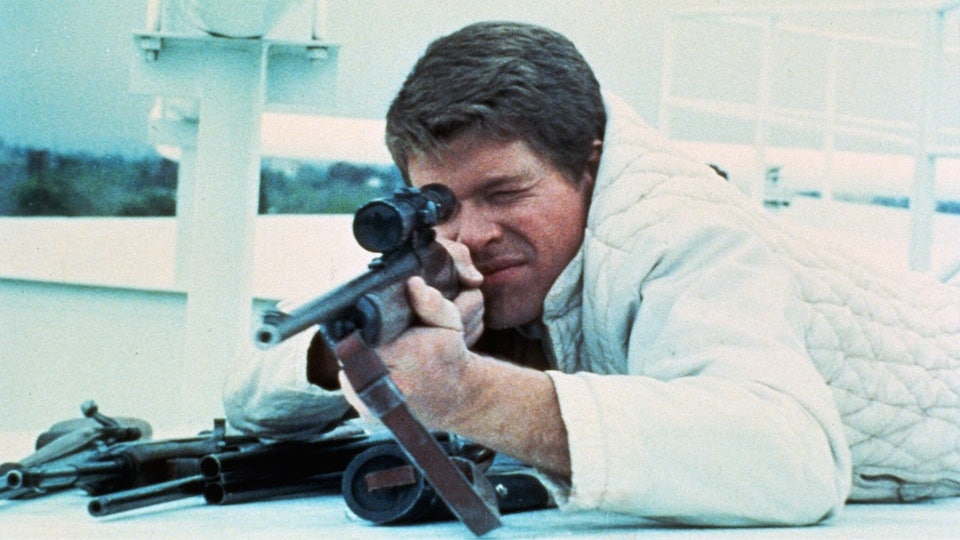
Targets (USA, 1968) 90 min color DIR-PROD: Peter Bogdanovich. SCR: Peter Bogdanovich, Samuel Fuller (uncredited). STY: Polly Platt. DOP: László Kovács. CAST: Boris Karloff, Tim O’Kelly, Nancy Hsueh, James Brown (no, not that James Brown), Sandy Baron, Mike Farrell. (Paramount Pictures)

I have seen this film twice under “borrowed” circumstances. One Friday night in high school, I had rented this, along with Bullitt and Once Upon a Time in the West, to watch at my father’s, when I looked after his place while he was away for the weekend. (He had a VCR. My mother had yet to own one.) The next time was three years later, when this aired on A&E as the Friday night 8 o’clock movie. (Those were the days- when a flick like this ran as the 8 o’clock movie on A&E. Those were the days- when A&E still had arts and entertainment!) My mother didn’t pay for the extra cable package that included specialty channels such as this, but her sister did. I bribed my cousin with a couple of beers so I could come over on the Friday night with my VCR and record this movie- and naturally, to edit the commercials out. My intensions were for the betterment of humankind.
This was the time when I went back to high school at age 20. In addition to taking a full day’s course load, I was working full-time shift work, and had also during this school year made my first movie, and starred in two plays! As if my schedule wasn’t already crowded enough, another ambition was to revive the school’s long-dormant Film Club. Showing Targets would’ve been a perfect way to kick it off. It’s a “movie buff’s movie”, which is to say, it’s a really neat little flick that deserves an audience much bigger than a discerning crowd of cultists who attend midnight movie revivals and comb the subterranean corners of TV Guide.
Fittingly, Boris Karloff’s last great role is also perhaps his most human personage on camera, starring as horror film actor Byron Orlok, announcing his retirement because his movies can’t compete with real life horror. As if to prove that point, the narrative spends as much time with all-American boy Bobby Thompson (played by Tim O’Kelly – whatever happened to him?), who guns down his wife and family, then goes on a shooting spree on highway drivers from atop a silo (in a scene based on real-life killer Charles Whitman, whose University of Texas tower shootings were fresh in public conscience). Their lives intersect when the killer continues at the drive-in where Orlok’s new movie premieres. The film’s lack of musical score just intensifies the suspense, and gives O’Kelly’s character an even more frightening lack of rationale. (Some prints still have an anti-gun pre-credits roll, which was also added due to Senator Robert Kennedy’s assassination.) The cinematography of László Kovács, and production design by Polly Platt both lend the film a bright, antiseptic look of the “every day” and familiar, all the more upsetting when that world is usurped with violence.

This one-of-a-kind movie is often unbearably suspenseful (could you imagine seeing this at a drive-in?) and with a clever “real life vs. reel life” motif. Orlok/Karloff watches himself in Howard Hawks’ The Criminal Code on TV; director Bogdanovich (whose career had many homages to Hawks) also takes an onscreen supporting role, playing a young director. The Karloff movie The Terror plays the movie on the drive-in screen; in a marvellous bit, the killer becomes confused between the onscreen Orlok and the real-life actor advancing towards him. Nancy Hseuh (one of the first Asian American actresses to have a leading role in a TV series) has a refreshingly three-dimensional role as Orlok’s assistant.
This marked Peter Bogdanovich’s “official” directorial debut picture, after working on Voyage to the Planet of Prehistoric Women, a Roger Corman mash-up of footage from a Russian sci-fi movie with newly-shot scenes of Mamie Van Doren, and working without credit on Corman’s The Wild Angels. On these films, Bogdanovich also worked with Polly Platt, then his wife, who would support her husband’s early breakthrough films (including The Last Picture Show and What’s Up, Doc?) as a costume and production designer until, shall we say, Cybill Shepherd came along.
(PS- I never did do the Film Club. My schedule remained crowded for most of the year. But still, if I was do another, one of my first choices would be to show this. It is still a movie for more people to discover. Paramount had released this to VHS and DVD; as of this writing, the DVD is out of print, and sells for mad money on the secondary market.)
